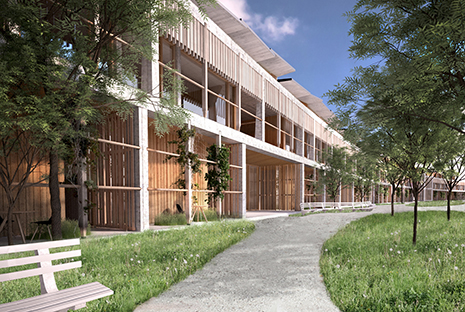Description
To create a sense that each patient room at the Children’s University Hospital in Zurich is an individual entity, the design emphasises a frequently neglected aspect of patient rooms: the ceiling. The symbolic notion of a roof over one’s head imparts a sense of shelter and being looked after in the unsettling situation of being ill and in hospital.
An international competition for the design of a new building for the University Children’s Hospital in Zurich was launched in 2011, and subsequently won by the architects Herzog & de Meuron. With 200 beds, including 51 intensive care and neonatal beds, it is the largest hospital for the inpatient and outpatient treatment of children and young people in Switzerland. In addition to treating a range of highly specialised medical conditions, it also incorporates spaces for research, teaching and the promotion of young academics in the field of paediatrics.
These two facilities – an acute care hospital and a research and teaching unit – are housed in two buildings. The Akutspital on the south site is a three-storey, strongly horizontal building located opposite the existing “Burghölzli”, the Psychiatric University Hospital in Zurich. The main entrance to the new building, a large opening, is exactly opposite the historical portal of the existing building and the concave gesture of the entrance façade creates a large joint forecourt for both institutions.
Inside, the Akutspital is designed like a gridded city with streets, intersections and squares. Each floor has a main street and the functional facilities are their quarters. A large number of planted inner courtyards of different sizes illuminate the interior and punctuate the orthogonally organised interior space. Some of the courtyards are more conspicuous due to their round shape and are arranged along the main street near the entrances to the most important functional areas.
The wards are located on the top, the most private level of the Akutspital. Designed as quadrants, they contain a total of 114 rooms arranged in a ring and oriented outwards. Both single and two-bed rooms are equipped with sofas that can be converted into sleeping accommodation for parents and relatives. They also have a work area for the nursing staff. Each individual patient room is designed as a small house with its own roof, ensuring privacy for the young patients and their relatives in combination with an expansive view. By staggering the arrangement of the rooms and varying the roof incline, each individual room is legible as a separate unit: this elementary, immediately comprehensible form expresses the individuality of each patient within the larger complex of the hospital.
Drawings
Photos
 Rendering of the exterior
Rendering of the exterior
 Rendering of a typical patient’s room
Rendering of a typical patient’s room
Originally published in: Wolfgang Sunder, Julia Moellmann, Oliver Zeise, Lukas Adrian Jurk, The Patient Room, Birkhäuser, 2020.

